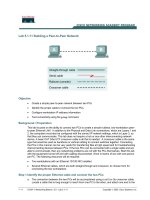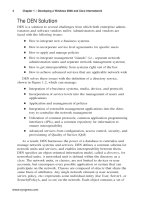Building a devops culture
Bạn đang xem bản rút gọn của tài liệu. Xem và tải ngay bản đầy đủ của tài liệu tại đây (2.26 MB, 27 trang )
Building a DevOps Culture
DevOps is as much about culture as it is about tools
Mandi Walls
Building a DevOps Culture
by Mandi Walls
Copyright © 2013 Mandi Walls. All rights reserved.
Printed in the United States of America.
Published by O’Reilly Media, Inc., 1005 Gravenstein Highway North,
Sebastopol, CA 95472.
O’Reilly books may be purchased for educational, business, or sales
promotional use. Online editions are also available for most titles
(). For more information, contact our
corporate/institutional sales department: 800-998-9938 or
April 2013: First Edition
Revision History for the First Edition
2013-04-15: First Release
2015-09-25: Second Release
The O’Reilly logo is a registered trademark of O’Reilly Media, Inc. Building
a DevOps Culture, the cover image, and related trade dress are trademarks of
O’Reilly Media, Inc.
While the publisher and the authors have used good faith efforts to ensure
that the information and instructions contained in this work are accurate, the
publisher and the authors disclaim all responsibility for errors or omissions,
including without limitation responsibility for damages resulting from the use
of or reliance on this work. Use of the information and instructions contained
in this work is at your own risk. If any code samples or other technology this
work contains or describes is subject to open source licenses or the
intellectual property rights of others, it is your responsibility to ensure that
your use thereof complies with such licenses and/or rights.
978-1-449-36893-7
[LSI]
Chapter 1. Introduction
After a few years of talking about “What is DevOps?”, a general consensus
has started to form around DevOps being a cultural movement combined with
a number of software development practices that enable rapid development.
As a technical process, tools have emerged that enable teams to work more
quickly and efficiently. Tools alone are not enough to create the collaborative
environment that many of us refer to now as DevOps. However, creating
such an environment is a huge challenge; it requires assessing and realigning
how people think about their teams, the business, and the customers.
Putting together a new set of tools is simple when compared to changing
organizational culture. DevOps is a departure from traditional software
development practices for just this reason. By celebrating anti-social
superstar developers, or allowing code to go to production that wasn’t
properly tested, or deciding that the only reason the code doesn’t run is
because Operations is stupid, we are not doing our best to enable the business
and create value for our customers.
There are those among us who were “doing devops before DevOps.” The
most successful, rewarding projects I have worked on in my career were
those that had an open, professional culture, but by attaching a common
vocabulary, we can give others a blueprint for adjusting their organization’s
culture toward one that is more DevOps-like.
Chapter 2. What Is
Organizational Culture?
The concept of organizational culture was developed in the middle of the
20th century, ostensibly by Edgar Shein at MIT Sloan. The idea that a group
of people working together in a corporate environment could create a culture
distinct from the greater societal culture is now fairly well accepted in many
industries. IBM and Walmart are well known for having cultural
characteristics that separate them from competitors, for good or bad.
Groups of people create a culture through shared values and behaviors. How
we reward behaviors, how we treat those values as malleable or immutable
affects how strong the organization’s culture is and how well it is supported
by the participants. It also affects how the members of the culture will react
to attempts to modify the characteristics of that culture.
The last few years have seen a lot of discussion of what DevOps is and isn’t.
DevOps is as much about culture as it is about tools, and culture is all about
people. No two groups of people are guaranteed to create the same sort of
culture under similar circumstances. So to talk about a cultural movement in
absolute terms is disingenuous. Implementing a prescribed toolchain won’t
magically turn your team into a DevOps team. Using DevOps-friendly tools
and workflows can help your team work in a more DevOps manner, but
creating a culture that is supportive of the ideals of the DevOps movement is
crucial.
We added a Velocity Culture track to the 2010 Velocity Conference out of
recognition that there are important cultural aspects of successfully operating
large infrastructures. What is more challenging, however, is how to help
aspiring DevOps cultural warriors make modifications to their organizational
cultures in order to reap some of the benefits of DevOps. Cultural change in
general is a topic widely discussed in business research, and we can borrow
from lessons learned by other industries.
Chapter 3. What Exactly Makes a
Culture “DevOps”?
Culture, as an abstract collection of ideas and behaviors, is hard to pin down
to a proscriptive set of requirements. In a technical team, it’s much more easy
to talk about what kinds of tools to use and how to use them; the tools
themselves are accessible as constructs. The people that will use those tools
are complex.
The traditional friction between teams thought of as “development” and
teams thought of as “operations” boils down to a few key cultural
characteristics.
Open Communication
A DevOps culture is one created through lots of discussion and debate.
Traditionally siloed technical teams interact through complex ticketing
systems and ritualistic request procedures, which may require director-level
intervention. A team taking a more DevOps approach talks about the product
throughout its lifecycle, discussing requirements, features, schedules,
resources, and whatever else might come up. The focus is on the product, not
building fiefdoms and amassing political power. Production and build metrics
are available to everyone and prominently displayed. The current
infrastructure is documented, and maybe someone went to the trouble of
having it printed on a plotter, which is totally cool.
Incentive and Responsibility Alignment
One of the early controversial aspects of what became DevOps was the
assertion that Engineering should be doing on-call rotations. In fact, this idea
was presented in a way that made it sound like your developers would want
to be on call if they were truly dedicated to building the best possible product,
because they were the ones responsible for the code.
I don’t remember now who first articulated this point; my personal DevOps
epoch begins with John Allspaw and Paul Hammond’s Flickr talk at Velocity
2009, and they may have mentioned it. Regardless, the cultural characteristic
here is empowerment. The people who are empowered to directly make an
improvement are the ones who are alerted to the defect.
Likewise, your team is incentivized around your core goal: creating an
awesome product for your customers, whatever that product happens to be.
Development isn’t rewarded for writing lots of code. Operations isn’t
punished when all that code doesn’t run as expected in production. The team
is rewarded when the product is awesome, and shares in the improvement
process when the product could be more awesome.
Respect
All team members should respect all the other team members. They don’t
actually all have to like each other, but everyone needs to recognize the
contributions of everyone else, and treat their team members well. Respectful
discussion and listening to other’s opinions is a learning experience for
everyone. No team member should be afraid to speak for fear of being abused
or rudely dismissed.
Trust
Trust is a massive component of achieving a DevOps culture. Operations
must trust that Development is doing what they are because it’s the best plan
for the success of the product. Development must trust that QA isn’t really
just there to sabotage their successes. The Product Manager trusts that
Operations is going to give objective feedback and metrics after the next
deployment. If any one part of the team doesn’t trust another part of the team,
your tools won’t matter. Additionally, if you don’t trust the people who work
for you, why are they working there? Why are you?
Chapter 4. Ready, Set, Change
One thing is for sure: we cannot “greenfield” human beings the way we can
tear down an application and rebuild it in another environment. We can’t
theorize about spherical cultures in a vacuum to simplify our equations. We
see this every day in society; the residual effects of cultural change writ large
in our day-to-day lives. The Civil Rights movement in the United States
didn’t wipe out the previous culture and start over; there are still people
whose opinions about such things are “from another era.”
People come with baggage: preconceived notions, past experiences,
prejudices. When these individual characteristics are at odds with the culture
that we want to foster in our organizations, we create stress. Alleviating that
stress means either changing the person or changing the organization they
belong to.
Changing the values of our organization is a challenging task, one that has
been under study by management scholars for decades. There are numerous
interesting case studies about disastrous cultural change initiatives, failed
cultural integrations from mergers, and investigations into what makes
cultures change. We are not alone in our struggles to better serve our
businesses by improving our work cultures and processes. Searching on the
Harvard Business Review website for “cultural change” will get you 60+
publications going back nearly 30 years.
One recent anecdote that I found particularly interesting was buried in a story
from The Atlantic about recent trends in repatriating manufacturing work to
the United States after years of moving those tasks abroad for labor cost
savings.
The story of GE’s GeoSpring water heater is fascinating, regardless of the
underlying drama of globalization and outsourcing. The product was
designed in the U.S. and the specifications were sent to Asia for production;
the manufacturing process became a black box that the design team sent
instructions to. When looking at how to manufacture this particular product
in the U.S., they brought together “design engineers,…but also
manufacturing engineers, line workers, staff from marketing and sales” to
discuss how best to build it, and discovered the design was “terrible” and no
one actually wanted to try to build it.
It sounds like Development wrote some code and “threw it over the wall” to
Operations to figure out, doesn’t it?
GE’s integrated team sat down and redesigned the product with input from
everyone, and ended up building a better product, at lower cost. It’s what we
want for our technology products too, the ability to best serve the business
and create value. The cultural shift is acknowledging that everyone has
valuable input and communicates. This was a DevOps cultural shift. It is a
change in the value of some new behaviors versus the old ones.
Know Where You Are Starting
When we first join new organizations, we go through a learning process,
discovering the mores and acceptable behaviors of that organization, be it a
new company, a sports team, or the PTA. It’s common to get different
answers to questions like “Why are we doing X this way?” from different
people. When we hope to change the prevailing culture of the group, we need
to assess the current state of that culture, and ask all of the questions about
why we’re doing X the way we are.
The one question you must ask is “What is our primary business goal?” You
need to know what people have decided is the motivating factor for the
business as they know it. If the organization’s leadership has done a good job
of communicating the organization’s goals, you’ll find most people are on
point. It’s not uncommon, though, to hear some folks claim that the business
goal is “We’re a content company; we produce awesome content for our
users” and others “We’re an ads-placement company; we sell ads to make
money for our advertisers.” Or maybe, “We provide a stable application for
our users” versus “We are driving innovation and leading the competition in
new features.” Are these goals mutually exclusive? No, but they represent a
difference in viewpoint that will color people’s actions and decisions when it
comes to the products they work on.
In an ideal situation, you’ll have some sort of consensus. Even if you have
two related goals, you’re doing mostly OK. The comedy of errors starts when
you have several divergent ideas of what the company is actually trying to
accomplish. The reasons for this often include poor communication from
management as to what the company is driving toward. It’s also possible that
fuzzy goals like “serving the customer in the best way possible” are different
for different teams in your organization, especially if they have different
“customers.”
Now that you know the goal of your business, you can take this knowledge
and focus your DevOps cultural change toward enabling this business and
working toward this goal.
Know Why You Are Changing
Proving change is necessary requires some legwork. It’s fine to want to
change your organization because “everyone” is doing DevOps now, but
you’re looking at months of work, new tools to learn and implement, teams to
restructure. These costs must be outweighed by the benefits, so you have to
be able to put real value on your processes.
Articulating upfront what your goals are will help you with other phases of
your DevOps roll out. Some common measurable goals are:
Reduce time-to-market for new features.
Increase overall availability of the product.
Reduce the time it takes to deploy a software release.
Increase the percentage of defects detected in testing before production
release.
Make more efficient use of hardware infrastructure.
Provide performance and user feedback to the product manager in a more
timely manner.
These goals have monetary impacts on your business. It costs you peoplehours when your software releases take days. It costs you revenue when the
product isn’t available for use by your customers. It increases your operating
costs to run your infrastructure in a non-efficient way. Taking what you know
about these values, you can put a monetary value on improving any of them.
Additionally, all of these goals can have a numerical threshold attached to
them. “Reduce deployment time from 10 hours to two hours.” “Increase
percentage of defects detected in testing from 25% to 50%.” You can reason
about these numbers and judge the success of your transition process.
These goals also give you a stable platform for obtaining support from the
rest of your organization. Starting from metrics such as “It currently requires
six team members 10 hours to deploy a new release of our product. This costs
us $X for every release” provides a concrete number for comparison as you
implement your DevOps changes. It attaches real value to a real pain point in
a way that is more constructive than “Our deployments suck.”
Executive Sponsorship
Getting most folks on the same page is a job best sent up the org chart as far
as you can push it. In order to make changes to things like compensation and
incentives, you need to get management buy-in at a high enough level that
any necessary changes can be facilitated without a battle. This is one distinct
advantage small organizations have over large ones, the ability to make
tweaks to core human resources functions in order to influence the behavior
of individuals.
Having an executive sponsor is also helpful when spreading the good news
about your cultural adjustments. It gives your teams a feeling that they aren’t
going off on a hunt for DevOps nirvana only to have the plans changed on
them a few months down the road. Resist the urge to start a grassroots
movement; in this case, getting permission comes with more resources than
asking forgiveness later.
Your executive sponsor is going to be particularly interested in the
measurable goals you’ve developed, and will likely have their own that might
fit in with your DevOps goals.
Technical Leadership
In the process of implementing a DevOps culture, you will likely be asking
your technical staff to change their tools, behaviors, and workflows. You will
want someone on hand to be your go-to person to talk about DevOps to your
teams. It might be you! And that is awesome! It could also be an architect or
other senior person who is well liked and well respected, or a few of these
folks so you don’t overburden a single person.
This person, or team of people, will serve an important role, a combination of
evangelist, tools expert, process subject-matter expert (SME), and buddy.
They’re like your camp counselors. They’ll teach a little bit, answer
questions, reassure the reluctant, and bring the marshmallows at the end of a
long day. These folks are hard to find, and often aren’t who you think they
are. The last person you want for a job like this is someone who’s smart but a
complete jerk everyone hates but who happens to know how to use the tools.
Find the people who everyone wishes were on their team, borrow some of
their time, and form a working group to help other teams.
Without these folks to shepherd the various factions of your organization, it’s
easy to lose a few sheep along the way. Your SMEs can be there to build
interpersonal relationships and open communication paths with outside
teams, cutting down on friction and politics.
Pilot Projects
At this point you know you’re going DevOps. Your management is on board
and ready to help as necessary. Your tiger team is only a couple people so far,
but they’re enthusiastic and well respected. Now what?
Now you need a pilot project. You have to find somewhere to start in your
project portfolio. You are going to transform not just the product that the
pilot team is building, but the processes, workflows, and team dynamics. As
you’ve been talking to people in your company, getting feedback on things
like goals and who’s awesome, you’ve probably piqued the curiosity of more
than a few folks. You might have multiple projects that want to try out your
fancy new DevOps processes that you can choose from to start a pilot.
What makes a good pilot candidate? Lots of different project characteristics
can make a good pilot. Most importantly, you don’t want to start too big the
first time out. Rolling out the DevOps machine for a key central service is
going to be hugely frustrating while you’re figuring out which tools work
best for your environment and how to improve your communications and
processes.
You also don’t want something that is too small. It’s easy to dismiss a tiny
pilot project with “Oh, sure, that team can do DevOps because they’ve only
got five people. We have six in QA alone; it will never work!”
The first time out, try for a project team that is collocated. Changing up
process and communication is hard; doing it across five timezones is a good
hurdle to avoid if you possibly can. If all your teams are distributed, look for
teams with a long history of working successfully across long distances.
Their team culture may already reflect some of the characteristics of a
DevOps culture that you’re looking for.
Set Goals
Remember those goals from earlier? Now you’re going to apply them directly
to your pilot project.
Choose the goals that most make sense for the individual project, be it
reducing time to market, increasing efficiency, reducing deployment time, or
whatever. Talk with the project team. They have problems they want to
improve, pain that needs to be alleviated.
Finally, give these goals a timeline. If your organization is using an agile
methodology, work with that, do sprints, reassess, set new goals, keep
improving incrementally. You’ll be taking time to install and learn new tools
and processes, so at the beginning work may seem slower than you think it
should be.
Chapter 5. Mentoring the New
Culture
As your pilot project progresses, you’ll be mentoring the product team in the
values that foster a DevOps environment: communication, responsibility,
respect, and trust.
Fostering open communication channels is the foundation of a successful
DevOps culture. One of the most common complaints from many Operations
teams is that they weren’t aware of an impending change, or weren’t told
about a new product feature. When I have asked these folks if they attend the
Development team’s standup meetings, the answer I typically hear is “No, we
don’t go to their meetings, they never talk about anything that concerns
Operations.” Open communication leads to better collaboration throughout
the entire team. Every team member should know that he or she can go to any
other member of the team to ask a question, and expect to get an answer or
some kind of help in finding one.
Your new DevOps-style standup meeting includes everyone. Your
developers, your QA engineers, your system administrators, all of them get
together to discuss what they’re working on. The benefit of this single change
is immense, and even if you’re reading this article and thinking “This isn’t
for me,” bringing a full team together to intentionally talk about the product
on a regular basis is going to help you build a better product.
Maybe your developers are working on how the product is going to use a new
third-party API. They’re talking about credentials and authorization with that
third party. QA will need to know how to write tests to flex the features; do
they need fake accounts or dummy users? Your sysadmins will have
questions about the SLA of the API, how failures will be monitored and
rolled up for reporting. What if the API has an outage? The whole team has
worked on the metrics and information necessary for the product manager to
make an informed decision on disabling the feature. When everyone knows
up front what new features are in the pipeline, it will be less likely for any of
these topics to be missed. This makes your product more reliable and gives
your customers a better experience.
Another aspect of opening communications is logistical. Your best bet for
successful communications is with people who sit together or have a common
physical space that allows for chance interactions and conversations. Think
about the conferences you have attended. The “hallway track” is often just as
awesome as the talks. People get to meet in person and talk in real time about
interesting things. The product your team is building benefits from this
unfettered communications. Get your folks some dedicated white boards to
work on and share ideas. Facilitate all avenues of communication.
If your team is not permanently collocated, bring them together for as long as
you can at the beginning of the project. You want them to get to know each
other, talk to each other, and begin to gel as a team. A week is probably the
minimum; two is better.
Your next hurdle is realigning the responsibilities of your team. The scariest
part of this step is fixing your broken on-call schedule. Guaranteed, if only
your system administrators have ever been paged about your product, your
responsibility model needs to be updated. It should be obvious; if the desire is
to have the product be as awesome as it possibly can be, every bump, burp, or
error in the code would report back to the person who wrote that code and is
most likely to understand what is wrong in order to start the process of fixing
it. Fault recovery processes in siloed teams are full of wasted time while
additional input is requested from people who didn’t think they needed to be
available.
Similarly, Dev and QA shouldn’t be the only ones creating tests for the
product. If your team is adopting DevOps practices in order to put more
product features in front of customers more often, you want to be confident
that the way you’re installing the product’s requirements or new
infrastructure will behave properly with your product. This requires testing.
How you test varies with the availability of hardware resources and the tools
your team might be using. Making it a priority to test infrastructure changes
is assigning value to a new behavior, changing the incumbent culture.
Mentoring your team around respect derives from how you resolve
interpersonal conflicts among team members. Team members need to feel
that everyone is being treated fairly and has a voice. Sometimes teams fight,
and fighting it out over a difficult topic isn’t always a bad thing. But it’s
possible to have a good fight and a bad fight. Personal attacks and namecalling are obviously not the kinds of behaviors you want in a collaborative
team, and you have to deal with them from a managerial standpoint. These
are the difficult discussions for many managers, and it is tempting to sit back
and let people deal with their conflicts. Do not be tempted to ignore
destructive behaviors; engage the people who are fighting in a constructive
discussion, work through the sticking points, and mediate a compromise if
one is warranted. This is a good place to ask one of your SMEs to help
mediate and act as an impartial judge.
Finally, your team members will learn to trust each other over time. The
changes to behaviors in communication, responsibility, and respect build an
open, collaborative environment. Your team will build new relationships that
they wouldn’t have had in an otherwise siloed environment. It may take a
while for your team to heal from whatever post-deploy PTSD may be
haunting their nightmares.
Chapter 6. Checkpoints and
Declaring Victory
Your new DevOps-enabled team is going to be busy. They’re learning how to
use some new tools, they are learning to work together in more productive
and efficient ways. You want them to know when things are going well.
Part of choosing good goals, with metrics attached to them, is that you can
put up some graphs and see how the team is improving toward those goals.
You can prove to the team that deployment time has improved, and by how
much. The product manager is hopefully ecstatic that the new features
customers have been suggesting are now in sight for making it into
production on a more efficient timeline.
In addition to the metrics related to your goals, you also need to check in with
your team members, one-on-one. While we all hope that the team is excited
to be working more closely and getting a better product out, you still have to
check on everyone and see how they are doing as individual people.
Finally, as a manager, you get to declare victory and throw a party. After
working through a multifaceted project, it’s important to stop, recap, and
celebrate. Choose a milestone that represents a significant amount of work,
and plan to pause. When facilitating a large cultural and behavioral change,
you want a little bit of time to assess the impacts of these changes, not just to
the team directly involved, but also to any tangential teams. Hopefully other
teams are getting interested in changing their behaviors, and they can come to
you, your team, and your SMEs for help. Creating some documentation
around lessons learned and the challenges you faced will help other teams
heading in a DevOps direction.
Then buy your team some cupcakes, or go to the movies, or do anything that
says “We just did something difficult. We learned good new things, we
unlearned bad old things, and we created a great product. Together.”









